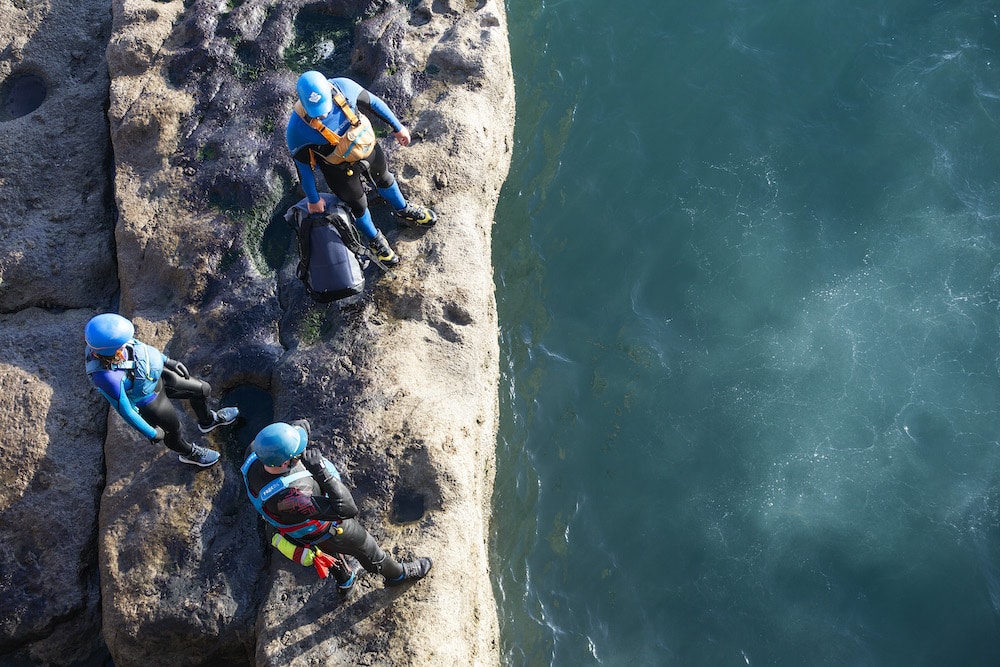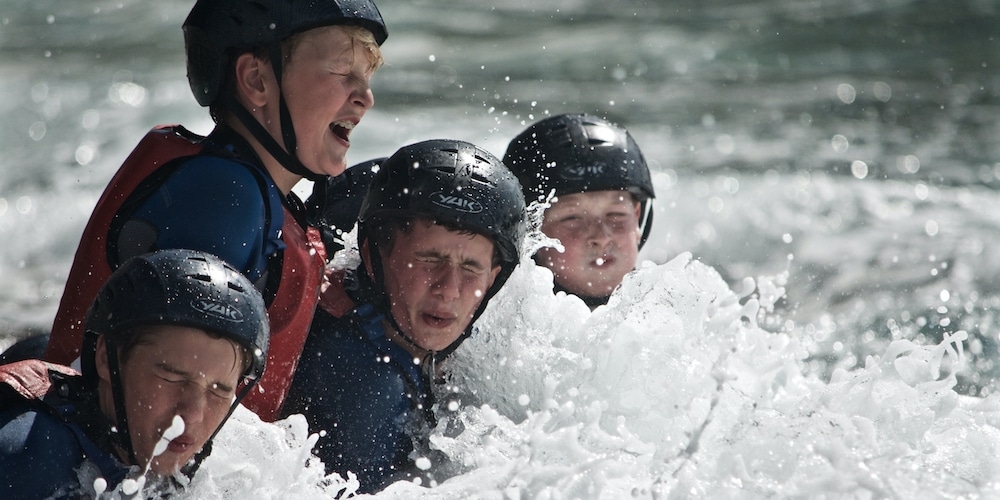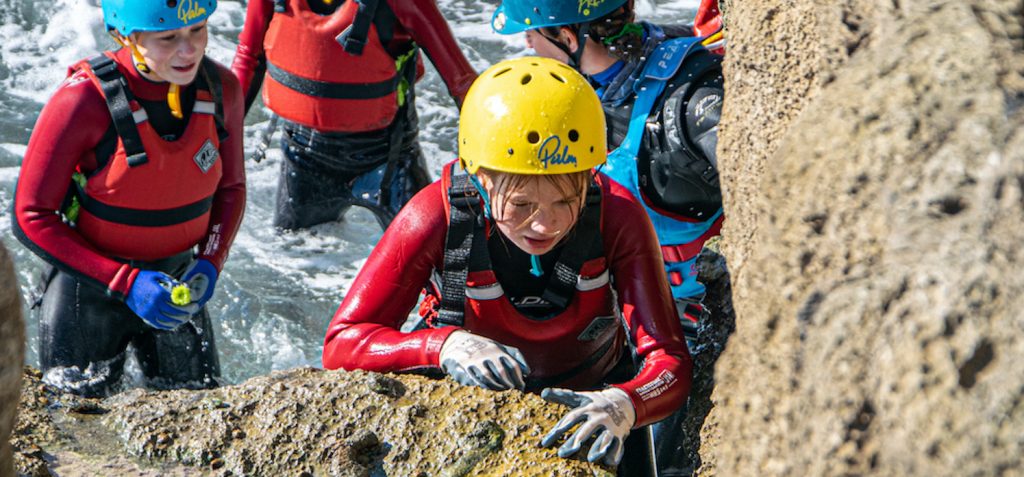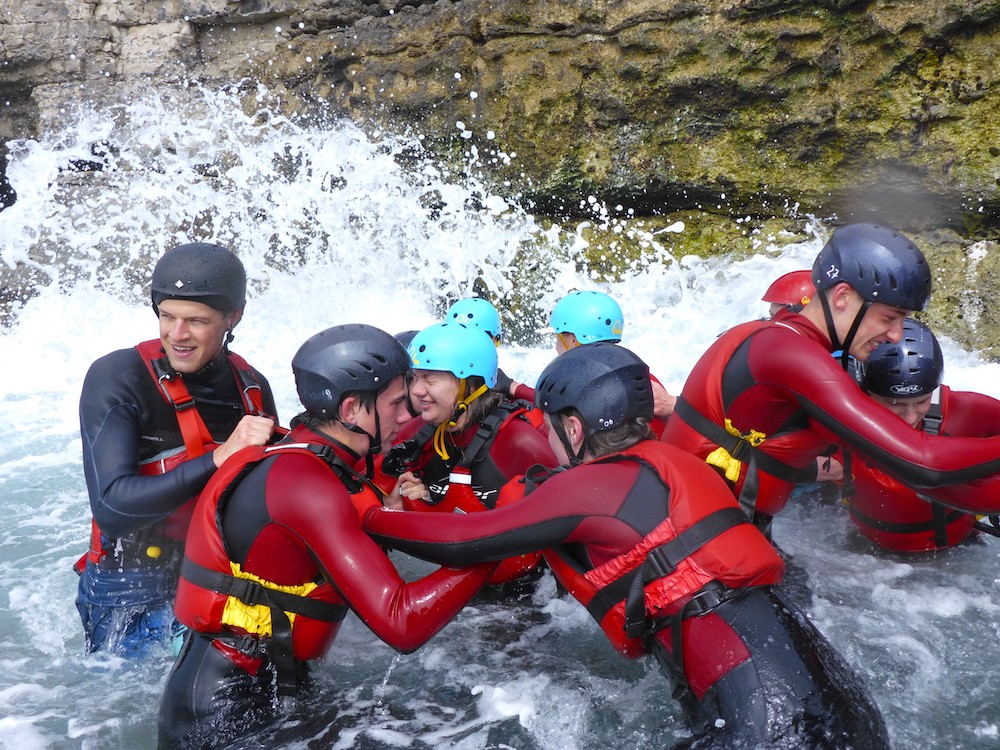Coasteering in Dorset provides some of the best locations in the UK
What is coasteering?
In a nutshell coasteering is exploring a stretch of coastline, getting from point A to point B above and below the tide line on foot or by swimming. To do so practitioners of the sport scramble on the rocks which separate the sea from the land, leap from the rocks splashing down into the water and swim to a suitable exit point to make progress along the route.
At Land and Wave, this is one of our favorite activities! We love nothing more than to take people out along our charming coast, whether this be your first coasteering experience or you’ve had plenty of fun doing it before. After you’ve finished reading this post, check out what coasteering experiences we offer here!
Coasteering is an adventure sport and should be approached in the correct way with appropriate knowledge and equipment to ensure a safe and fun time is had by all. We have put together an adventurer’s guide to coasteering in one of the most beautiful parts of our country – The Jurassic Coast, Dorset. Learn everything there is to know about this popular activity which is quite simply an exhilarating experience.

What equipment is required for Coasteering
As with all outdoor sports, it is vital to be dressed appropriately when participating in coasteering. Luckily, unlike activities such as kayaking and paddleboarding, you do not need much equipment for coasteering but rather just a few bits of kit:
Wetsuit – You should opt for a full-length wetsuit for coasteering which is suitable for the water temperature. Having all of your skin covered will not only help to keep you warm during a prolonged period of being absolutely drenched, it will also help protect your skin from scrapes against rocks and sunburn. Double winner!
Trainers or light boots/hard soled wetsuit booties – The intertidal zone (area between high and low tides) will normally mean that the rocks can be extremely slippery. Good fitting, lace up shoes with a grippy sole will help when scrambling over rugged areas.
Interesting fact about rocks, they are hard and sharp. We can confirm slipping over onto them or attempting to walk over them barefoot looking like Bambi on ice is 100% not enjoyable and not recommended. Appropriate footwear will make coasteering much more pleasurable.
Buoyancy aid – A lot of time will be spent very much in the sea. Swims between exit points can, in some cases, be a substantial distance and once you add waves and current into the mix, they can be a serious undertaking.
A buoyancy aid will help greatly in providing, well… buoyancy. This will make your time in the water much less demanding and more comfortable. Make sure that your buoyancy aid fits correctly as it will help to keep your face comfortably above the water allowing for easy breezy breathing. Correctly fitted, it should be snug around the torso and should not rise up above the head when you pull at the shoulder straps.
Helmet – Coasteering can involve exploring beautiful and incredible caves which have entrances very low to the water level. For most people their head is important to them, containing their brain and lots of information. Sadly, I’m not one of those people. I’m pretty much empty between my big ears but even I try to protect my noggin by wearing a helmet!
What does coasteering involve?
Swimming
‘Wild’ or ‘open-water’ swimming is a huge part of coasteering and is a lot more physically demanding than a leisurely soak in your local indoor swimming pool. Being in the sea in choppy conditions amongst rocks with an imposing cliff looming over you will get the adrenaline flowing! Swimming also allows us to access places inaccessible by foot, like the forgotten sea caves that we explore at Dancing Ledge with our groups!
Jumps
To test your nerves and push your limits, coasteering involves jumping from the rocks into the sea. Normally a good coasteering route will have plenty of opportunities to jump off rocks of varying heights. They can be anything from a foot above the water to higher than an Olympic diving board. It is important to do it right to avoid hurting yourself.
You should always check the depth of the sea where you are jumping into as sea levels can vary drastically. As jumps get higher, you should also jump in control and enter the water correctly – feet first, like a pencil, with your arms crossed over your chest and tighten your core. Whereas smaller jumps can be a bit more, shall we say, experimental.

Scrambling
You can count on doing lots of scrambling and sea level traverses when you’re coasteering. If you are not swimming in the water or jumping into it, you’ll be on the rocks. An unlimited source of fun travelling in all directions up, down, left and right, at water level or gaining some height (pretty proud of that rhyme). Rocks are basically a climbing frame waiting to be played on!
Coasteering Hotspots in Dorset
The Jurassic Coast is a fantastic place; firstly, it’s beautiful. It also has a huge variety of different rock types and a great deal of fossils. Ammonites (the swirly spiral fossils) as big as car tyres can be found at the bottom of the large cliffs.
The different layers of rock along this stretch of our coastline along with many years of erosion of the softer rocks, has left behind outcrops of the harder rocks. We therefore get very interesting features appearing like the well know Durdle Door and Lulworth Cove.
These rock formations provide perfect destinations to go coasteering with steep rock faces, many boulders and ledges at sea level and deep enough water below to make swimming and diving-in possible.
One such location and our favourite spot to take people coasteering is Dancing Ledge in Swanage. It’s about a mile walk to get to Dancing Ledge from the National Trust ‘Spyway’ car park which is the closest access. It starts relatively flat across farmers’ fields before opening into a stunning view looking down to the cliffs and the path you will have to take down.
After you reach cliff level you have to descend into the old quarry to reach Dancing Ledge. The ledge itself sticks out into the sea where it will sometimes be underwater or exposed depending on the tides. As water washes over the ledge, the surface of the rock makes the water erupt into a dance – supposedly where the name comes from.
There is a short scramble down from the quarry to water level, which is where the fun really begins. Multiple jumps of different heights offer a challenge for everyone. There’s even the option to jump off the ledge all together in a line!
Off to the side of the ledge there are beautiful sea caves and plenty of sea level rocks. When it is wavy the area around the rocks is a fun place to be as the sea pulls you back and forth and, with some care and guidance, you can really feel the power in the water as it washes you around. Just make sure you preserve some energy for the walk back up!

Portland
Portland is another great venue in Dorset for coasteering. The Isle of Portland sticks right out into the sea and is basically one giant lump of hard Portland stone. For an age it has resisted the relentless pounding of the elements, leaving a broken and harsh coastline full of potential for exploration and jumps. Portland Bill which is the southernmost point of Dorset is a very popular spot.
Although it is renowned to have very strong tides, so be sure to go with someone who knows the area well or double down on the research and forecast. Side note – Portland Stone is the very rock that some of London’s most famous landmarks are constructed with; Buckingham Palace, St Pauls Cathedral and Tower Bridge to name drop a few.
When accessing a chosen coasteering venue please do stick to public rights of way. Firstly, this helps stop the unnecessary creation of new paths, the destruction of wild flora or crops and ultimately prevents easily avoidable erosion. Secondly, veering off of public rights of way can lead to accidental trespassing and we don’t want any angry farmers chasing people in wetsuits across the countryside (as funny as that would be to see)!
The Lulworth Estate which Lulworth Cove, Stair Hole and Durdle Door belong to specifically ask that people do not climb on the rocks without permission. Although these may be fun Coasteering destinations, you cannot simply turn up and play like some other spots. Bear this in mind when planning your trip!
Conditions
Although the coastline stays fairly constant in regards to the shape of the cliffs and rocks, the conditions around your planned coasteering route can vary massively. This needs to be taken into consideration before heading out to play. Looking up, reading and understanding both the weather and tidal forecasts will help you decide when is ideal to go coasteering and when it’s best to stay at home as it’s just too gnarly out there.
Speaking of things being too gnarly, a bit of thought before you leave home can save a lot of effort and even your life later on down the line. As with all adventure sports there is an element of risk. Be aware that if things do go sideways, which could happen even on the most pleasant of days, there is rarely phone signal down on the cliffs.
Never go coasteering alone or in conditions you are not certain you can handle. Always make sure that a third party, i.e. someone not involved in the activity, knows exactly where you are planning to go and when you are due to be contactable again.
They can then contact the emergency services if they do not hear from you at the agreed upon time. It is important you stick to these timings strictly so that they do not raise the alarm without reason and waste the time of the emergency services.

Fun for everyone
Coasteering is an activity for everyone! Not only do you get wet and have fun, but you can also benefit in other ways; learning more about your own resilience and what you can do. At Land and Wave our Outdoor Instructors adjust the coasteering sessions according to the group’s ability and the conditions.
Groups of kids can benefit hugely from a coasteering session. Dancing Ledge is a great venue to allow ‘challenge by choice’ without peer pressure or necessity to perform. Your young ones will be able to make their own choices (within reason!), as to how high they want to jump. It could be just from sea level, or it could be something higher.
The instructors will give the choice and let them make their own mind up to grow their comfort zones at their own pace, without forcing them straight into the panic zone. Check out the Youth Activity Days we run at Land and Wave here.
I am a firm believer in the saying: ‘behind every successful man there is a strong woman’.. I like to think that this woman is ready to push her man off of something, and what better place than while coasteering…
The whole family can enjoy themselves whilst getting in some proper bonding time, working together to help each other overcome physical and/or emotional boundaries. Check the family options we provide at Land and Wave here.
Or maybe the ladies ‘don’t need no man’ and would like to leave the family at home and enjoy a day out in the elements, experiencing land, sea and air in all its glory for that special day ladies wait a lifetime for… their hen do. Stag do’s on the other hand might get a rougher ride, deservingly so. A rowdy bunch of blokes out for a laugh might get a healthy dose of peer pressure to aid people into the water, all adding to the enjoyment. Check out our stag and hen do options here.

Plan your trip!
So there you have it – an adventurer’s guide to coasteering in Dorset! We want to close by reminding everyone to please do bear it mind that it is highly recommended to go coasteering with a reputable company or highly experienced & qualified individual.
Not only will they be trained and competent at keeping you safe, they will also have vast knowledge of the area and already know all the great spots along the coastline to show you. We hope you find this guide useful.. now go a get a taster session booked and we hope you enjoy coasteering as much as we do.




